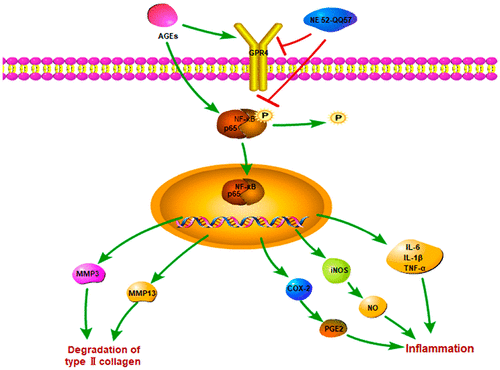当前位置:
X-MOL 学术
›
Chem. Res. Toxicol.
›
论文详情
Our official English website, www.x-mol.net, welcomes your
feedback! (Note: you will need to create a separate account there.)
Antagonism of GPR4 with NE 52-QQ57 and the Suppression of AGE-Induced Degradation of Type II Collagen in Human Chondrocytes.
Chemical Research in Toxicology ( IF 3.7 ) Pub Date : 2020-05-06 , DOI: 10.1021/acs.chemrestox.0c00111 Haochuan Liu 1 , Yulong Liu 1 , Bing Chen 2
Chemical Research in Toxicology ( IF 3.7 ) Pub Date : 2020-05-06 , DOI: 10.1021/acs.chemrestox.0c00111 Haochuan Liu 1 , Yulong Liu 1 , Bing Chen 2
Affiliation

|
Osteoarthritis (OA) is a common degenerative joint disease for which an effective therapeutic strategy has not yet been established. AGEs are widely recognized as a contributor to OA pathogenesis. GPR4, a recently discovered proton-sensing transmembrane receptor, has been shown to possess a wide range of physiological functions. However, the potential role of this receptor in chondrocytes and the pathogenesis of OA is unclear. In the present study, we investigated the potential of GPR4 to modulate the effects of advanced glycation end products (AGEs) in SW1353 human chondrocytes. First, we demonstrate that GPR4 is fairly expressed in SW1353 chondrocytes and that exposure to AGEs increases the expression of this transmembrane receptor. Second, we found that antagonism of GPR4 with NE 52-QQ57 significantly inhibited the AGE-induced increased expression of several key inflammatory cytokines and signaling molecules, including tumor necrosis factor-α (TNF-α), interleukin (IL)-1β, IL-6, inducible nitric oxide synthase (iNOS), nitric oxide (NO), cyclooxygenase 2 (COX2), and prostaglandin E2 (PGE2). We also found that antagonisn of GPR4 had a remarkable ability to rescue type II collagen from AGE-induced degradation by inhibiting the expression of matrix metalloproteinase (MMP)-3 and MMP-13. As a key pro-inflammatory signaling pathway, we further tested the effect of GPR4 antagonism on the activation of nuclear factor-κB (NF-κB) and found that NF-κB activation was indeed suppressed, thereby indicating that the NF-κB signaling pathway may mediate the effects of GPR4 antagonism described above. These findings provide a basis for further research into the role of GPR4 -mediated signaling in OA.
中文翻译:

GPR4与NE 52-QQ57的拮抗作用以及AGE诱导的人软骨细胞II型胶原降解的抑制作用。
骨关节炎(OA)是一种常见的退行性关节疾病,尚未建立有效的治疗策略。AGE被广泛认为是导致OA发病的原因。GPR4是最近发现的质子感应跨膜受体,已被证明具有广泛的生理功能。然而,尚不清楚该受体在软骨细胞中的潜在作用和OA的发病机理。在本研究中,我们研究了GPR4调节SW1353人软骨细胞中高级糖基化终产物(AGEs)的作用。首先,我们证明GPR4在SW1353软骨细胞中公平表达,并且暴露于AGEs会增加该跨膜受体的表达。第二,2(PGE 2)。我们还发现,GPR4的拮抗剂具有通过抑制基质金属蛋白酶(MMP)-3和MMP-13的表达而从AGE诱导的降解中拯救II型胶原的显着能力。作为关键的促炎信号通路,我们进一步测试了GPR4拮抗作用对核因子-κB(NF-κB)活化的影响,发现NF-κB活化确实受到抑制,从而表明NF-κB信号通路可能介导上述GPR4拮抗作用。这些发现为进一步研究GPR4介导的信号传导在OA中的作用提供了基础。
更新日期:2020-05-06
中文翻译:

GPR4与NE 52-QQ57的拮抗作用以及AGE诱导的人软骨细胞II型胶原降解的抑制作用。
骨关节炎(OA)是一种常见的退行性关节疾病,尚未建立有效的治疗策略。AGE被广泛认为是导致OA发病的原因。GPR4是最近发现的质子感应跨膜受体,已被证明具有广泛的生理功能。然而,尚不清楚该受体在软骨细胞中的潜在作用和OA的发病机理。在本研究中,我们研究了GPR4调节SW1353人软骨细胞中高级糖基化终产物(AGEs)的作用。首先,我们证明GPR4在SW1353软骨细胞中公平表达,并且暴露于AGEs会增加该跨膜受体的表达。第二,2(PGE 2)。我们还发现,GPR4的拮抗剂具有通过抑制基质金属蛋白酶(MMP)-3和MMP-13的表达而从AGE诱导的降解中拯救II型胶原的显着能力。作为关键的促炎信号通路,我们进一步测试了GPR4拮抗作用对核因子-κB(NF-κB)活化的影响,发现NF-κB活化确实受到抑制,从而表明NF-κB信号通路可能介导上述GPR4拮抗作用。这些发现为进一步研究GPR4介导的信号传导在OA中的作用提供了基础。









































 京公网安备 11010802027423号
京公网安备 11010802027423号